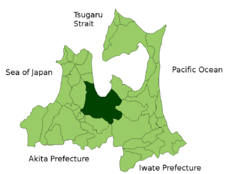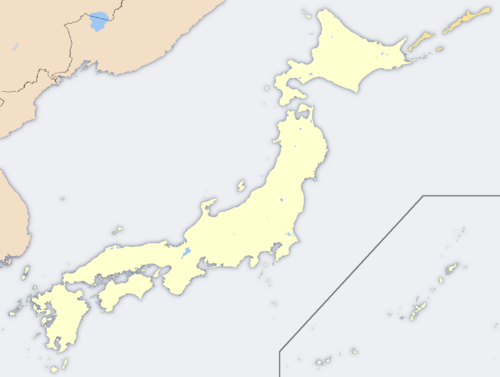Aomori, Aomori
 Aomori's location in Aomori Prefecture, Japan. |
|
 Aomori's location in Japan. |
|
| Location | |
| Country | Japan |
| Region | Tōhoku |
| Prefecture | Aomori Prefecture |
| Physical characteristics | |
| Area | 824.52 km2 (318.35 sq mi) |
| Population (as of April 1, 2005) | |
| Total | 314,786 |
| Density | 373.62 /km² (968 /sq mi) |
| Location | |
| Symbols | |
| Tree | Maries' Fir |
| Flower | Rugosa Rose |
| Bird | Owl |
| Others | Insect: Firefly |
 Flag |
|
| Aomori Government Office | |
| Mayor | Seizō Sasaki |
| Address | 1-22-5 Chūō, Aomori-shi, Aomori-ken 030-0822 |
| Phone number | 017-734-1111 |
| Official website: City of Aomori | |

Aomori (青森市 Aomori-shi?) is the capital city of Aomori Prefecture, Japan. The city faces the Tsugaru Strait via Mutsu Bay to the North and the Hakkōda Mountains to the South. It has the biggest seaport in the prefecture. Before the Seikan Tunnel opened, Port Aomori connected the city via train ferry to Hakodate in Hokkaidō, and therefore the city served as the main entrance to Honshū for passengers and cargo to and from Hokkaidō.
Though the town and port were settled in 1626, the city of Aomori was officially founded on April 1, 1898. On April 1, 2005 Aomori increased in size by merging with the neighboring town of Namioka.
Aomori literally means blue (or green) forest. The name is generally considered to refer to a small forest on a hill which existed near the town. This forest was often used by fishermen as a landmark. A different theory suggests the name might have been derived from the Ainu language.
Contents |
History

The area has plenty of Jōmon period ruins, the most famous among them being the Sannai Maruyama ruins located just southwest of the city center where the remains of a large wooden building was unearthed. This discovery would ultimately revolutionalize Japanese archeology pertaining the era.
Before the early Edo period, Aomori was a small fishing village called Utō (善知鳥村 Utō-mura?).
As the Edo period began, Utō-mura was brought under the control of the Tsugaru clan, and became part of the Tsugaru han. As the clan established the capital in Hirosaki, Utō-mura also began to develop.
In 1612 the Port Development Officer of Tsugaru, Moriyama Yashichirō, under orders of the daimyō, Tsugaru Nobuhira, began development of Utō-mura, adopting the name to Aomori and making it into the local seaport and trade center for Hirosaki.
During the Meiji Restoration the han system was abolished and the prefecture system was established. In July of 1871, Aomori became a part of Hirosaki prefecture, succeeding the area covered by the Tsugaru han. Due to a merger on September of that year, Hirosaki prefecture (encompassing the same area as present-day Aomori prefecture) was founded. The prefectural capital however, was moved from Hirosaki to Aomori soon after the merger and the prefecture was renamed to Aomori prefecture.
Shortly after this merger, the 5th Infantry Regiment of the Japanese Imperial Army, and later in 1896 the 8th Division of the Japanese Imperial Army were stationed in Aomori.

In the winter of 1902, as the Russo-Japanese War was looming, 210 soldiers left Aomori to cross the Hakkōda Mountains toward Hirosaki for a military cold-weather readiness exercise. The severe weather conditions, in combination with poor preparation and organization as well as a breakdown in leadership resulted in 199 of the 210 soldiers perishing in the rugged mountain passes. Only a handful of survivors, led by Fusanosuke Gotō, managed to return to Aomori. A short while later, a similar party, leaving from Hirosaki, managed to take the pass by going in the opposite direction, counter-clockwise, and arrive in Aomori unharmed.
On July 28, 1945 Aomori was bombed by 61 United States Army Air Corps B-29s. The bombers dropped both high explosives and incendiary bombs, the resulting firestorm claimed 1,767 lives instantly. Many more would die in the weeks and months following the attack from injuries suffered during the July raid.
The development of modern Aomori was primarily due to its prefectural capital status and the singular importance of the Seikan ferry, which connected the ports at Aomori and Hakodate in Hokkaidō. The ferry was initially run by the Ministry of Trains but later it was taken over by Japanese National Railways. From 1908 to 1988 the ferry served as the primary transport between the island of Honshū and the northern island of Hokkaidō. In March of 1988, the Seikan Tunnel opened up, travelling under the Tsugaru Strait, this quickly replaced the slow-moving ferry as the primary transportation between the two islands.
Climate
Snow and cold weather characterize the winter climate in Aomori. The city and its surrounding area is renowned for its heavy snowfall, which is said to be the heaviest among all Japanese cities. In 1981 the city recorded a maximum snow cover of 196 cm. In contrast, Sapporo's heaviest snowfall occurred in 1939, and that was only 164 cm. The particularly heavy snow is caused by several winds that collide around the city. This makes the air rise and cool, resulting in rapid and thick cloud formation and precipitation.
In summer, a cool wind called Yamase frequently blows from the east, which sometimes results in extremely cool weather and poor harvests. Additionally, thick fogs are often observed in mountainous areas in the summer. Due to this fog, flights to Aomori Airport are often canceled.
Transportation
Aomori Airport (established in 1964 with international flights beginning 1995) is about a 30 minute drive from the city, with bus service available. There are flights to Tokyo, Itami (near Osaka), Chūbu Centrair International Airport (near Nagoya), Sapporo, Fukuoka and Seoul, South Korea (through Korean Air). In summer, flights to Russia (through Dalavia Far East Airways) are also available.
Aomori Station is located downtown, near the Aomori Port. The station is served by JR East as the northern terminus of the Tohoku and Ōu Main Lines. The Hokkaidō Railway Company also runs trains on the Tohoku Main Line track to Hachinohe, and owns the Tsugaru Kaikyo Line to the north which runs through the Seikan Tunnel to Hokkaidō.
In 2015 the Hokkaidō Shinkansen will connect Shin-Aomori station with Shin-Hakodate station in Hokkaido via high-speed bullet train service through the Seikan Tunnel.
Seikan Ferry continues to operate ferries to Hakodate. It takes about four hours to go by ferry from Aomori to Hakodate.
Sightseeing
Aomori Nebuta is a famous festival performed from August 2 to August 7 every year. Besides this, major attractions of Aomori include ruins, museums, and mountains. Hakkōda Mountains are good locations for trekking with hot spas. Aomori is also home to several hot spas (onsen), such as Asamushi and Sukayu.
- Asupamu
- Munakata Shiko Memorial Museum of Art
- Aomori City Forestry Museum
- Aomori Prefectural Folk Museum
- Aomori City History and Folk Arts Museum
- Nebuta-no-sato Museum
- Sannai-Maruyama Ruins
- Asamushi Aquarium
Sport
Aomori has hosted two international curling events, both in 2003, and the local women's "Team Aomori" was selected to represent Japan at the 2006 Winter Olympics in Turin, Italy [1]. From March 17 - 25, 2007, it will host the World Women's Curling Championships[2].
Education
Aomori is the only prefectural capital in Japan which has no national university, instead, nearby Hirosaki became the site for the prefecture's highest educational facility.
- Aomori Akenohoshi Junior College
- Aomori Prefectural Aomori High School
Famous people from Aomori
- Shiko Munakata (woodblock printmaker)
- Kyoichi Sawada (photographer)
- Hitoshi Saito (judoka)
- Takanori Hatakeyama (boxer)
- Daisuke Matsuzaka (pitcher)
Sister cities
- Hakodate, Hokkaidō Prefecture
- Kecskemét, Hungary
- Pyeongtaek, South Korea
External links
- Official website in Japanese
- Official website in English
- The 5th Winter Asian Games AOMORI 2003
- Sannai-Maruyama Site official website
- Pictures of Aomori, Japan ( Aomori city, Aomori Bay Bridge )
- Photos, report and advice about Nebuta Matsuri, Aomori's famous festival (one of the most famous festivals in Japan)
|
|||
| Cities | |||
|---|---|---|---|
| Aomori (capital) | Goshogawara | Hachinohe | Hirakawa | Hirosaki | Kuroishi | Misawa | Mutsu | Towada | Tsugaru | |||
| Districts | |||
| Higashitsugaru | Kamikita | Kitatsugaru | Minamitsugaru | Nakatsugaru | Nishitsugaru | Sannohe | Shimokita | |||
|